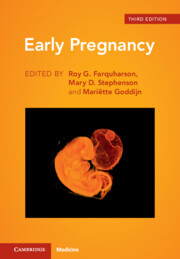Book contents
- Early Pregnancy
- Early Pregnancy
- Copyright page
- Contents
- Contributors
- Chapter 1 Novel 3-D Imaging Techniques in Early Pregnancy
- Chapter 2 What Is Endometrial Receptivity?
- Chapter 3 Pathophysiology of Chronic Endometritis
- Chapter 4 Clinical Management of Chronic Endometritis in Recurrent Pregnancy Loss
- Chapter 5 Implantation
- Chapter 6 Early Placental Development and Disorders
- Chapter 7 The Uncertain Science of Preimplantation Genetic Testing for Reproduction
- Chapter 8 Thyroid Physiology and Early Pregnancy
- Chapter 9 Early Pregnancy Core Outcomes
- Chapter 10 Thyroid Treatment Trials
- Chapter 11 Müllerian Duct Development, Diagnosis and Management of Anomalies
- Chapter 12 Candidate Genes in Pregnancy Loss
- Chapter 13 Inherited Thrombophilia
- Chapter 14 Guidelines on the Diagnosis and Management of Sporadic Miscarriage
- Chapter 15 Investigation of Recurrent Pregnancy Loss
- Chapter 16 Talking with Patients about Pregnancy Loss
- Chapter 17 Psychological Support after Pregnancy Loss
- Chapter 18 Tubal Ectopic Pregnancy and Pregnancy of Unknown Location
- Chapter 19 Medical Management of Tubal Pregnancy
- Chapter 20 Candidate Biomarkers for Prediction of Pregnancy Location and Viability
- Chapter 21 Diagnosis and Management of Extrauterine Pregnancies
- Chapter 22 Ultrasound to Diagnose and Predict Early Pregnancy Outcome
- Chapter 23 Molar Pregnancy
- Chapter 24 COVID and Early Pregnancy
- Chapter 25 Obstetric and Perinatal Outcome after Assisted Reproductive Technology Pregnancy Events and Complications
- Chapter 26 Obesity and Early Pregnancy
- Chapter 27 Dynamic Prediction Models for Recurrent Pregnancy Loss
- Chapter 28 Pregnancy Loss: From Cytogenetics to Genomics
- Chapter 29 Progesterone Use in Early Pregnancy
- Index
- References
Chapter 16 - Talking with Patients about Pregnancy Loss
Published online by Cambridge University Press: 16 April 2025
- Early Pregnancy
- Early Pregnancy
- Copyright page
- Contents
- Contributors
- Chapter 1 Novel 3-D Imaging Techniques in Early Pregnancy
- Chapter 2 What Is Endometrial Receptivity?
- Chapter 3 Pathophysiology of Chronic Endometritis
- Chapter 4 Clinical Management of Chronic Endometritis in Recurrent Pregnancy Loss
- Chapter 5 Implantation
- Chapter 6 Early Placental Development and Disorders
- Chapter 7 The Uncertain Science of Preimplantation Genetic Testing for Reproduction
- Chapter 8 Thyroid Physiology and Early Pregnancy
- Chapter 9 Early Pregnancy Core Outcomes
- Chapter 10 Thyroid Treatment Trials
- Chapter 11 Müllerian Duct Development, Diagnosis and Management of Anomalies
- Chapter 12 Candidate Genes in Pregnancy Loss
- Chapter 13 Inherited Thrombophilia
- Chapter 14 Guidelines on the Diagnosis and Management of Sporadic Miscarriage
- Chapter 15 Investigation of Recurrent Pregnancy Loss
- Chapter 16 Talking with Patients about Pregnancy Loss
- Chapter 17 Psychological Support after Pregnancy Loss
- Chapter 18 Tubal Ectopic Pregnancy and Pregnancy of Unknown Location
- Chapter 19 Medical Management of Tubal Pregnancy
- Chapter 20 Candidate Biomarkers for Prediction of Pregnancy Location and Viability
- Chapter 21 Diagnosis and Management of Extrauterine Pregnancies
- Chapter 22 Ultrasound to Diagnose and Predict Early Pregnancy Outcome
- Chapter 23 Molar Pregnancy
- Chapter 24 COVID and Early Pregnancy
- Chapter 25 Obstetric and Perinatal Outcome after Assisted Reproductive Technology Pregnancy Events and Complications
- Chapter 26 Obesity and Early Pregnancy
- Chapter 27 Dynamic Prediction Models for Recurrent Pregnancy Loss
- Chapter 28 Pregnancy Loss: From Cytogenetics to Genomics
- Chapter 29 Progesterone Use in Early Pregnancy
- Index
- References
Summary
Early pregnancy loss is a common but distressing occurrence. Caring thoughtfully for women and others experiencing pregnancy loss and being able to listen to and understand their concerns can make a real and positive difference. Communication is key: communicating with patients clearly and thoughtfully, and delivering unexpected or bad news sensitively is hugely important. Health professionals may need to talk with and support patients and partners as they make difficult decisions within a short period of time, so should feel confident in talking about procedures including the benefits and risks of treatment. Equally, it is important for health professionals dealing with difficult situations to know how and where to find support for themselves, and to be aware of the resources the Miscarriage Association provides to both patients and professionals.
- Type
- Chapter
- Information
- Early Pregnancy , pp. 162 - 172Publisher: Cambridge University PressPrint publication year: 2025

